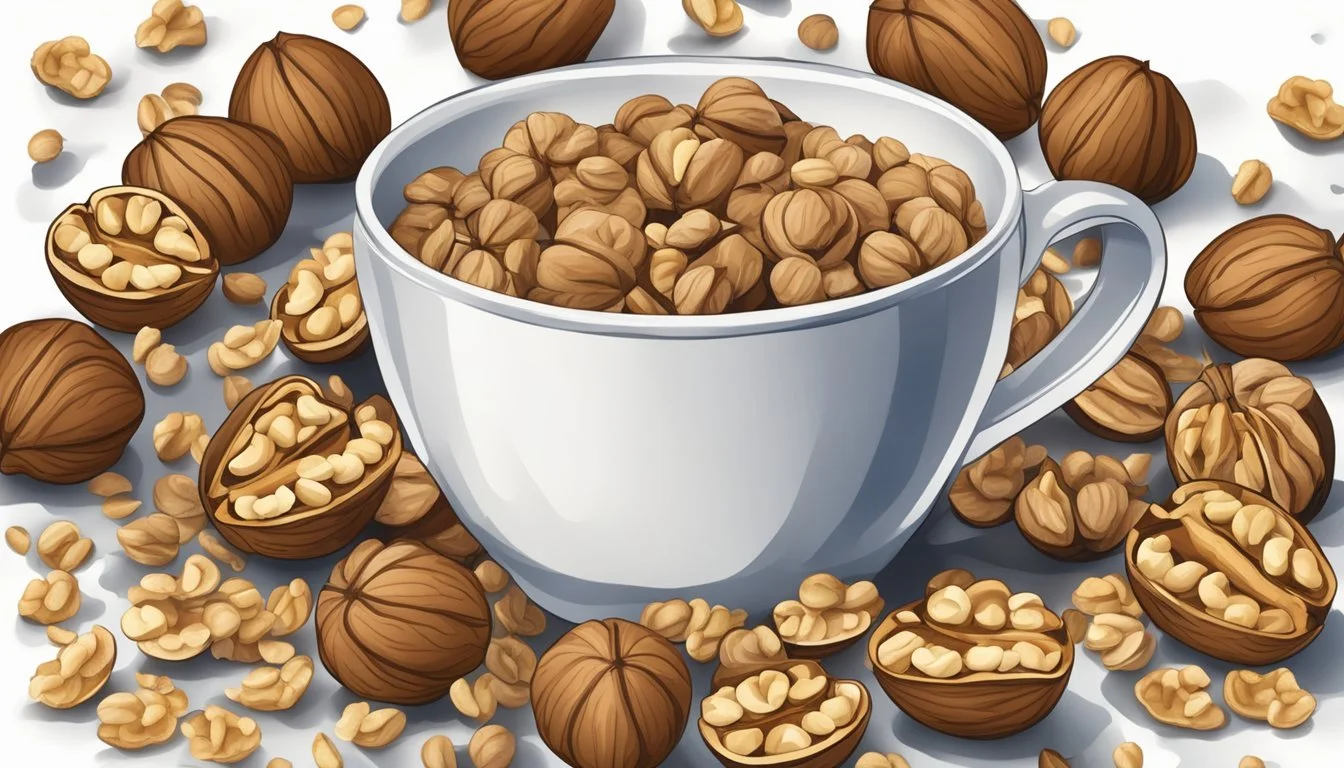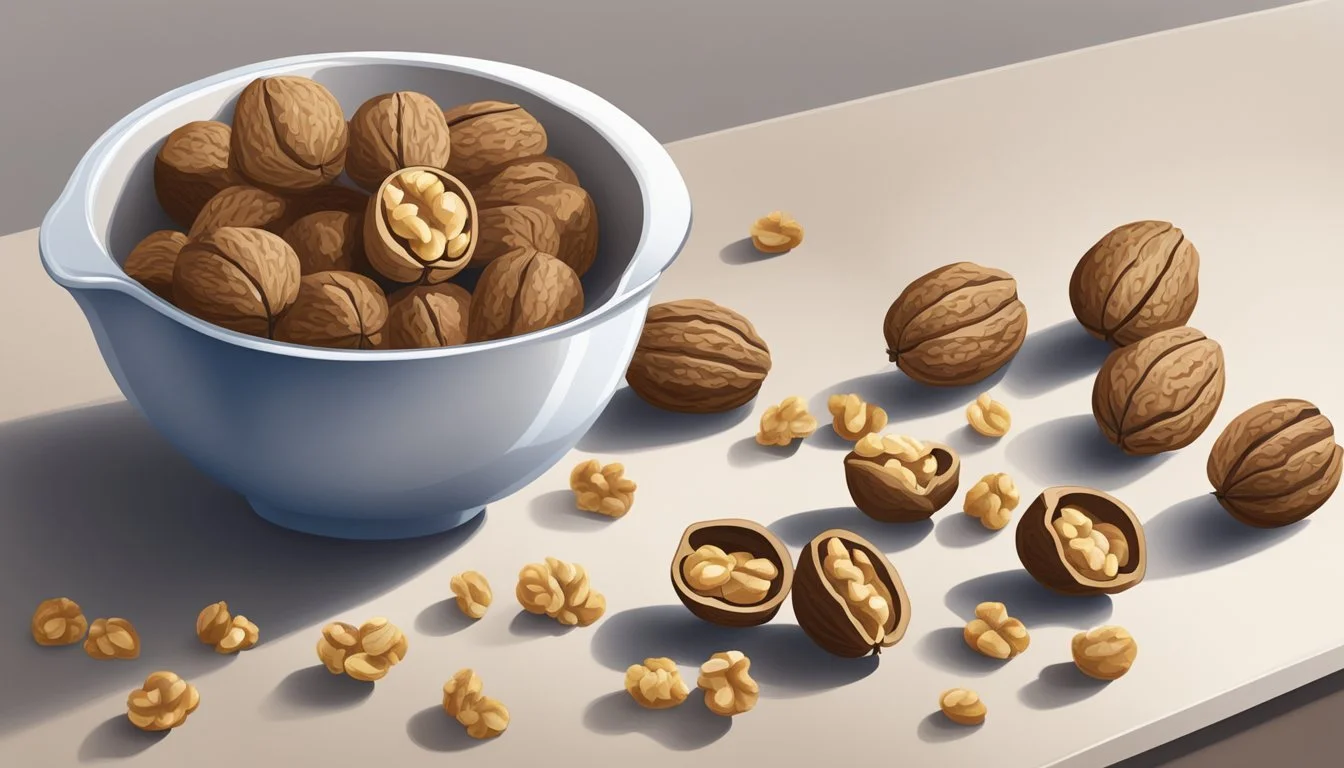How Many Cups in a Pound of Walnuts
Quick Measurement Guide
When measuring ingredients for cooking or baking, understanding the conversion of weight to volume is essential. Walnuts, a common ingredient known for their nutritious benefits and rich flavor, often require such conversion. A pound of walnuts can equate to different cup measurements depending on whether they are whole or chopped. Typically, a pound of whole walnut pieces translates to about 3.94 US cups.
For recipes that call for chopped walnuts, the texture and size of the pieces play a role in the conversion rate. Generally, a pound of chopped walnuts will yield 3 to 4 cups. The variation arises from the air spaces between chopped pieces, which can affect the overall measured volume. Precision is key in baking, so understanding these conversions ensures recipes are followed accurately for the best results.
Understanding Measurements in Cooking
Accurate measurements are critical in cooking for achieving the desired outcome, and this becomes even more crucial when dealing with ingredients like walnuts, where the conversion between weight and volume can vary significantly. In this section, the reader will gain insight into the different units of measurement and why distinguishing between volume and weight is essential for precision in culinary practices.
Units of Measurement
The units of measurement used in cooking are vital to the accuracy of a recipe. There are two primary types of measurements:
Weight:
Ounces (oz): A weight unit used in the Imperial system.
Pounds (lb): Equivalent to 16 ounces.
Grams (g): A metric unit of weight, with 1 ounce equal to approximately 28.35 grams.
Kilograms (kg): Another metric unit, where 1 kilogram equals 1000 grams.
Volume:
Cups (c): A volume unit commonly used in cooking for dry or liquid ingredients.
Tablespoons (tbsp): Smaller volume measurements, often used for precise ingredient amounts.
In the example of walnuts, chefs have to consider these units carefully, especially when converting between cups and pounds, as the space that chopped walnuts take up compared to whole walnuts can differ significantly.
Volume vs Weight
The difference between volume and weight is a crucial concept in the kitchen:
Volume is the space that an ingredient occupies, commonly measured in cups or tablespoons. A standard measuring cup is used to measure volume.
Weight refers to the mass of an ingredient, which is often best determined using a kitchen scale.
For instance, a cup of whole walnuts will weigh more than a cup of chopped walnuts because the smaller pieces fill the measuring cup more densely. As such, a recipe calling for one pound of walnuts requires attention to whether the walnuts are whole or chopped. To illustrate:
Whole Walnuts:
1 pound ≈ 2 to 2.5 cups
Chopped Walnuts:
1 pound ≈ 3 to 4 cups
Therefore, when a recipe specifies a pound of walnuts, knowing whether it refers to whole walnuts or chopped walnuts will affect the number of cups used. It is evident that using a kitchen scale to measure the weight in ounces or grams can provide a more accurate assessment than volume measurements for ingredients with variable sizes and densities.
Walnut Specifics
When dealing with walnuts, it is important to differentiate between various forms such as whole, chopped, shelled, and ground. The density and volume of walnuts can change significantly depending on how they are prepared and processed.
Whole walnuts typically have a larger volume compared to their chopped or ground counterparts. As a reference, a pound of whole walnuts usually equates to approximately 2 to 2.5 cups. This variance in volume can be attributed to the irregular shapes of the nuts and the spaces between them when measured.
In contrast, chopped walnuts have a smaller volume per pound due to the smaller pieces filling in gaps more effectively. On average, consumers can expect between 3 to 4 cups of chopped walnuts per pound. These specifications indicate that chopping the walnuts reduces the volume required to reach the weight of one pound.
For those utilizing shelled walnuts, which refer to walnuts without their hard outer shell, the measurement can differ slightly. The absence of the shell increases the density of the nut pieces in the measuring cup, potentially altering the cups per pound calculation.
The table below summarizes the conversion for walnuts in different states:
Walnut Type Cups per 1 Pound Whole Walnut 2 - 2.5 Chopped Walnuts 3 - 4 Shelled Walnuts* Varies
*Shelled walnuts can differ in volume due to varying degrees of chopping or breaking.
Understanding these distinctions is crucial for accurate recipe measurements and avoiding inconsistencies during food preparation.
Converting Pounds to Cups
When converting pounds to cups for walnuts, one should be aware that the volume measurement can vary depending on whether they are whole, chopped, or in pieces.
General Conversion Guidelines
One pound (1 lb) of walnuts typically equates to approximately 3 to 4 cups when dealing with chopped nuts. For whole walnuts, however, a pound might yield a measurement closer to 2 cups. These conversions are essential for accurate recipe measurements and can be used as a general baseline in the absence of a scale.
State of Walnuts Approx. Cups in 1 lb Whole Walnuts 2 cups Chopped Walnuts 3 to 4 cups
Factors Affecting Conversion
Several factors influence the conversion from pounds to cups. The size and density of the walnuts play a crucial role. Larger or smaller nuts will fill the cup differently, which means the same weight can yield a different volume. Additionally, whether the walnuts are shelled or unshelled, packed or loosely measured, affects the cup measurement. For instance, walnuts that are lightly filled in a cup versus those that are tightly packed will vary in weight despite occupying the same volume._translations are essential for accurate recipe measurements and can be used as a general baseline when a scale is not available.
Factors Impact on Conversion Size Affects volume measurement Density Alters weight-to-volume ratio State (Shelled/Unshelled) Changes weight of edible part versus whole Packing (Loose/Tight) Influences the number of walnuts per cup
Common Cooking Measurements
In every recipe, precision is key, and understanding common cooking measurements ensures that every meal is prepared consistently. Accurate ingredient measurements contribute to desired textures and flavors.
Standard Cup Measurements
Cups are a basic unit of volume used in cooking, particularly within the United States. The standard cup measure is crucial in recipe development. Here are common cup measurements and their equivalents:
1/4 cup = 4 tablespoons
1/2 cup = 8 tablespoons
3/4 cup = 12 tablespoons
1 cup = 16 tablespoons
One must also note that a stick of butter equals 1/2 cup, which is equivalent to 8 tablespoons or 4 ounces. When a recipe calls for cups, they're typically referring to this standard US cup measurement.
Converting Other Ingredients
Different ingredients have different densities, so they're measured differently. Here's a quick guide on how some typical baking ingredients convert from cups to pounds:
Sugar:
Granulated sugar: 1 cup = 7.1 ounces
Brown sugar (packed): 1 cup = 7.75 ounces
Flour:
All-purpose flour: 1 cup = 4.25 ounces
Cake flour: 1 cup = 4 ounces
Butter:
1 pound of butter = 2 cups or 4 sticks
For liquids like water and cream, 1 cup is equal to 8 fluid ounces. These measures are especially useful for accurately scaling recipes or converting between volume and weight for precise baking results.
Nutritional Value of Walnuts
Walnuts are a nutrient-dense food, comprised mainly of healthy fats and protein, and packed with beneficial minerals and vitamins. They're an excellent source of antioxidants and omega-3 fatty acids, contributing to various health benefits.
Health Benefits
Walnuts contain a significant amount of omega-3 fatty acids, which are known to support heart health and reduce inflammation. The antioxidants present, including vitamin E and polyphenols, can help combat oxidative stress and may lower the risk of certain diseases. Here is a brief list of essential nutrients found in walnuts:
Protein: Essential for muscle growth and repair.
Healthy fats: High in monounsaturated and polyunsaturated fats, including alpha-linolenic acid.
Fiber: Contributes to digestive health.
Vitamins: Such as vitamin B6, folate, and thiamin.
Minerals: Rich in manganese, copper, magnesium, and phosphorus.
Caloric Impact
Though walnuts are nutritionally rich, they are also calorically dense due to their high-fat content. A 1-ounce serving, approximately 14 walnut halves, contains about:
Calories: 185
Fat: 18.5 grams
Protein: 4.3 grams
Dietary Fiber: 2 grams
This caloric density means that while walnuts are beneficial, they should be consumed in moderation as part of a balanced diet.
Incorporating Walnuts into Recipes
When cooking with walnuts, one must consider the dish's flavor profile and the necessary measurements to maintain balance and texture. They offer a unique taste and can enhance the overall experience of numerous recipes, from desserts to salads.
Sweet vs Savory Dishes
Walnuts are incredibly versatile and can be included in both sweet and savory dishes for added texture and flavor.
Sweet Dishes: In desserts like brownies, cookies, or cakes, walnuts provide a rich, nutty flavor that contrasts well with sweet ingredients. Walnuts can be folded into batters, sprinkled as a topping on yogurt, or ground into fine pieces for a more subtle texture.
Savory Dishes: For savory recipes, walnuts can be used in salads or as a crunchy coating for proteins, adding depth with their earthy tones. They blend well with cheeses and greens, enhancing salads and pasta dishes.
Adjusting Recipes for Walnut Additions
When adding walnuts into recipes, consideration of the quantity is important to maintain the intended taste and consistency.
Measurements: If a recipe doesn’t call for walnuts but you decide to add them, remember that one pound of walnuts yields approximately 3 to 4 cups of chopped nuts. Use these measurements as a guideline to prevent overwhelming the dish.
Texture and Flavor: For baked goods, start by adding a half cup of walnuts to the mixture, ensuring the added volume does not affect the texture. In salads, a handful of chopped walnuts can be sprinkled on top to add a contrasting crunch without overpowering the primary flavors.
Shopping and Storage Tips
It is important for consumers to make informed decisions when buying walnuts at the grocery store and to understand the best practices for storing them to maximize shelf life.
Buying Walnuts
When purchasing walnuts, shoppers will find them available in various forms – whole shelled walnuts, walnut pieces, and chopped walnuts. Whole shelled walnuts tend to have a longer shelf life than their chopped counterparts. Prices can vary, but it's generally expected that walnuts should not exceed $5.00 per pound; often, they retail for around $4.00 or less. Buying in bulk can be economical, especially if the walnuts are fresh. Look for walnuts that appear unblemished and free from cracks or holes in the shells.
Storing Walnuts
Proper storage is key to preserving the quality and extending the shelf life of walnuts. They should be kept in a cold and dark place, ideally within airtight containers to prevent the oils from going rancid. For short-term storage, a cool pantry can suffice, but for long-term storage, placing them in the fridge or freezer is recommended. Whole nuts can last longer than processed ones; however, they should all be stored:
Refrigerator: Up to 6 months
Freezer: Over a year for optimal freshness
Understanding these aspects will ensure that walnuts are bought at their best quality and stored efficiently for long-lasting use.






